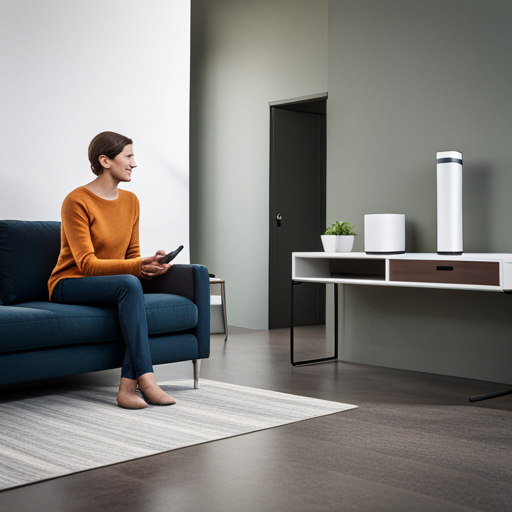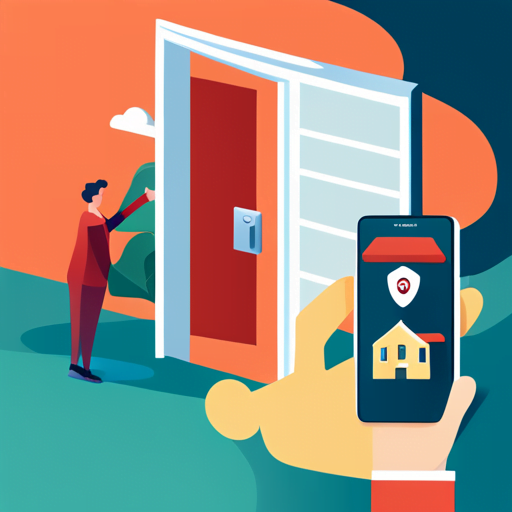
Are you curious about the future of voice control in smart homes? Get ready to be amazed by the possibilities! With advancements in voice recognition technology, you’ll soon be able to effortlessly control every aspect of your home just by speaking.
Imagine dimming the lights, adjusting the thermostat, and even ordering groceries – all with a simple command.
But as we embrace this exciting innovation, it’s also important to consider the potential challenges and security concerns that come with integrating voice control into our daily lives.
Key Takeaways
– Voice control in smart homes offers convenience and efficiency, improved accessibility, seamless automation, and independence for those with mobility challenges or disabilities.
– Advancements in voice recognition technology include improved accuracy, enhanced natural language understanding, multi-language support, and faster response times.
– Integration of voice control with other smart home devices allows for effortless control, enhanced convenience, seamless integration, control from anywhere in the house, and customized scenes and simultaneous device activation.
– Potential challenges and limitations of voice control include accuracy and reliability of speech recognition technology, ethical concerns regarding privacy and security, speech recognition errors and limited vocabulary, and background noise interference. Security measures and privacy considerations should be taken into account for voice control in smart homes.
Benefits of Voice Control in Smart Homes

You’ll love the convenience and efficiency of voice control in smart homes. With improved accessibility and seamless automation, voice control brings innovation right to your fingertips. Imagine waking up in the morning and simply saying, ‘Good morning, house.’ Instantly, your curtains open, your favorite music starts playing softly in the background, and the aroma of freshly brewed coffee fills the air. No need to fumble for switches or remotes; everything happens with just a few spoken words.
Voice control offers a level of convenience that was once unimaginable. Whether you want to adjust the temperature, turn on/off lights, or even lock/unlock doors, all you have to do is ask. It’s like having a personal assistant at your beck and call throughout your home.
Not only does voice control make life easier for everyone in your household, but it also promotes independence for those with mobility challenges or disabilities. Tasks that were once difficult or impossible are now within reach with just a simple command. From adjusting blinds to controlling appliances, everything is at your command without any physical effort.
In addition to improved accessibility, voice control provides seamless automation. By integrating various smart devices in your home through a central hub, you can create customized routines that respond effortlessly to your commands. Want to set the mood for movie night? Just say ‘Movie time,’ and watch as the lights dim, the blinds close automatically, and Netflix opens on your TV.
With voice control technology constantly evolving and becoming more sophisticated, innovation is always around the corner. So why not embrace this exciting future today? Experience improved accessibility and seamless automation with voice-controlled smart homes – an innovative solution designed for those who desire convenience at their fingertips.
Advancements in Voice Recognition Technology

With advancements in technology, it’s becoming easier to communicate with your home using just your voice. Voice recognition technology has come a long way, and the future predictions are even more exciting. Imagine being able to control every aspect of your home simply by speaking commands. The possibilities are endless.
Advancements in Voice Recognition Technology have paved the way for a truly connected smart home experience. Take a look at some of the impressive developments below:
| Advancements | Future Predictions |
|---|---|
| Improved accuracy | Seamless integration with all devices |
| Enhanced natural language understanding | Personalized user experiences |
| Multi-language support | Voice-controlled security systems |
| Faster response times | Gesture-based interactions |
These advancements not only make our lives more convenient but also increase efficiency and productivity. Just imagine waking up and saying “Good morning” to your house, and having it instantly adjust the lighting, play your favorite music, and brew a fresh cup of coffee.
The future holds even more exciting possibilities for voice control in smart homes. With ongoing research and development, we can expect to see innovations like emotion detection, predictive capabilities based on individual preferences, and even deeper integration with artificial intelligence.
Integration of Voice Control With Other Smart Home Devices

Imagine seamlessly integrating your voice commands with all of your other smart home devices. With the advancements in voice control integration, you can now take control of your entire smart home automation system using just your voice.
Here are some reasons why this innovation is a game-changer for smart homes:
– Effortless Control: No more fumbling with multiple apps or remotes. Simply speak out your commands and watch as your lights turn on, blinds close, and music starts playing.
– Enhanced Convenience: Voice control allows you to easily manage all aspects of your smart home from anywhere in the house. Whether you’re in the kitchen cooking or relaxing in the living room, controlling your devices is as simple as speaking a few words.
– Seamless Integration: With voice control integration, you can connect all of your smart devices together into one cohesive system. This means that not only can you control individual devices like thermostats or security cameras, but also create customized scenes that activate multiple devices simultaneously.
The future of smart homes lies in the seamless integration of voice control with other devices. It adds a new level of convenience and simplicity to managing your home automation system, making it easier than ever to create an innovative and connected living space.
Potential Challenges and Limitations of Voice Control

One potential challenge of integrating voice commands with other devices is the accuracy and reliability of speech recognition technology. While voice control has made significant advancements in recent years, there are still instances where it may misinterpret or fail to recognize certain commands. This can lead to frustration and inconvenience for users who rely on voice control as their primary means of interacting with smart home devices.
In addition to reliability issues, there are also ethical concerns surrounding the use of voice control in smart homes. As more devices become interconnected and capable of understanding and responding to voice commands, there is a need for increased privacy and security measures. Users must trust that their personal information will not be compromised or exploited through these voice-controlled systems.
To better understand the challenges and limitations of integrating voice control into smart homes, let’s take a look at the table below:
| Challenges | Limitations | Solutions |
| Speech recognition errors | Limited vocabulary | Continuous improvement |
| Background noise interference | Lack of contextual understanding | Advanced noise cancellation algorithms |
| Accidental triggering | Reliance on internet connection | User-defined wake words |
Security and Privacy Considerations for Voice Control in Smart Homes

To ensure the security and privacy of your personal information, it is crucial to implement robust measures when using voice commands in your interconnected devices. As voice control becomes more prevalent in smart homes, it brings with it certain vulnerabilities that can compromise data privacy.
Here are three key considerations for protecting your information:
– Secure Voice Recognition: Utilize advanced authentication methods, such as biometric recognition or unique voice patterns, to ensure that only authorized individuals can access and control your devices.
– End-to-End Encryption: Implement strong encryption protocols to protect the transmission of voice commands between your devices and the cloud servers they interact with. This prevents eavesdropping or interception by malicious actors.
– Regular Software Updates: Stay up-to-date with firmware and software updates for all your interconnected devices. Manufacturers often release patches and bug fixes to address any identified vulnerabilities or weaknesses.
Predictions for the Future of Voice Control in Smart Homes

In the future of voice control in smart homes, you can expect to see enhanced voice recognition technology that allows for more accurate and seamless interactions with your devices. This means that your commands will be understood even better, leading to a more efficient and satisfying user experience.
Additionally, there will be increased integration with AI assistants like Alexa or Google Assistant, enabling you to control not only your smart home devices but also access a wide range of information and services through natural language conversations.
Enhanced Voice Recognition
With enhanced voice recognition, smart homes will be able to understand and respond to your commands more accurately. This advancement in technology brings a new level of convenience and simplicity to your daily life.
Imagine being able to control every aspect of your home just by speaking naturally, without having to memorize specific commands or phrases. The improved accuracy of voice recognition algorithms ensures that your smart home understands exactly what you want, even in noisy environments or with accents.
Natural language understanding takes it a step further by allowing you to have fluid conversations with your smart home, making it feel like a true personal assistant. Say goodbye to complicated interfaces and hello to the future of effortless control over your smart home.
– Voice recognition technology that adapts to different voices
– Instant response time for faster and smoother interactions
– Integration with other devices for seamless connectivity
Integration With AI Assistants
Imagine how seamlessly your AI assistant can integrate with other devices, enhancing its capabilities and making it an even more valuable asset in your daily life. With AI assistant compatibility being a key focus in the world of smart homes, the possibilities are endless.
Picture this – you wake up in the morning and simply say, ‘Good morning,’ and your AI assistant springs into action. It adjusts the room temperature to your liking, turns on your coffee maker, and even starts playing your favorite playlist.
The accuracy of voice control has reached new heights, allowing you to effortlessly command your AI assistant from any corner of your home. Whether it’s managing lights, controlling appliances or answering questions, the integration between AI assistants and other devices is revolutionizing the way we interact with technology in our homes.
Embrace this innovation and let your voice be heard!
Frequently Asked Questions
How Does Voice Control in Smart Homes Benefit Individuals With Disabilities or Limited Mobility?
Voice control in smart homes greatly benefits individuals with disabilities or limited mobility. It enhances accessibility and has a profound impact on daily life, allowing you to effortlessly control various devices and perform tasks without physical limitations.
What Are Some of the Latest Advancements in Voice Recognition Technology That Are Making Voice Control in Smart Homes Even More Efficient?
Advancements in natural language processing have made voice control in smart homes even more efficient. Integration of voice control with virtual assistants allows for seamless interaction and increased automation, revolutionizing the way we interact with our homes.
Can Voice Control Be Integrated With Older Smart Home Devices That Were Not Initially Designed to Support This Feature?
Yes, you can use voice control with older smart home devices that didn’t originally support it. However, there may be possible security risks with voice-controlled smart home devices, so make sure to stay updated on the latest security measures.
Are There Any Potential Challenges or Limitations to Using Voice Control in Smart Homes, Such as Difficulties With Accent Recognition or Background Noise Interference?
You might face challenges with accent recognition and limitations due to background noise interference when using voice control in smart homes. But don’t worry, advancements in technology are constantly being made to overcome these obstacles and provide a seamless experience.
What Measures Are Being Taken to Ensure the Security and Privacy of Voice-Controlled Smart Home Devices, Especially Considering the Potential for Accidental Activation or Unauthorized Access to Personal Information?
To ensure the security and privacy of voice-controlled smart home devices, measures are being taken. Privacy concerns are addressed through encryption and user authentication. Accidental activations can be minimized by implementing more advanced voice recognition technology.
Conclusion
In conclusion, the future of voice control in smart homes looks promising. With advancements in voice recognition technology and seamless integration with other smart home devices, voice control offers numerous benefits for homeowners.
However, there are potential challenges and limitations to consider, such as accuracy issues and security concerns.
As technology continues to evolve, we can expect further improvements in voice control systems that will enhance our everyday lives and make our homes even smarter.
So get ready to enjoy a future where your voice becomes the ultimate remote control for your smart home!
As an Amazon Associate I earn from qualifying purchases.







